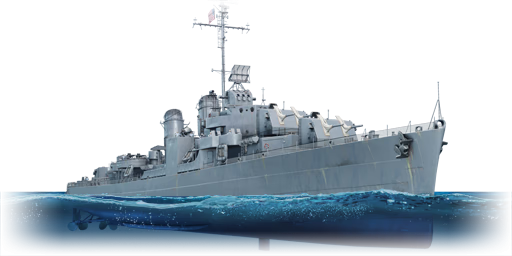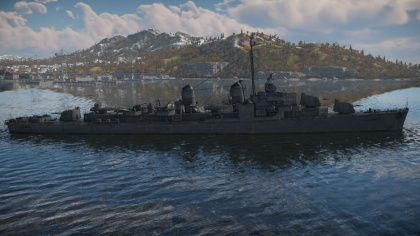Difference between revisions of "USS Sumner"
Tankninja1 (talk | contribs) (→History) (Tag: Visual edit) |
|||
| Line 25: | Line 25: | ||
|} | |} | ||
'''Notes:''' | '''Notes:''' | ||
| + | |||
* The radar atop the bridge is covered with an antifragmentation armour with 19 mm thickness. | * The radar atop the bridge is covered with an antifragmentation armour with 19 mm thickness. | ||
* Gun shields around the 20 mm Oerlikon autocannons are 12.7 mm thick. | * Gun shields around the 20 mm Oerlikon autocannons are 12.7 mm thick. | ||
| Line 33: | Line 34: | ||
{| class="wikitable" style="text-align:center" | {| class="wikitable" style="text-align:center" | ||
|- | |- | ||
| − | !colspan="3" | Mobility characteristic | + | ! colspan="3" | Mobility characteristic |
|- | |- | ||
! colspan="3" |Weight (tons) | ! colspan="3" |Weight (tons) | ||
| Line 39: | Line 40: | ||
| colspan="3" |3,218 | | colspan="3" |3,218 | ||
|- | |- | ||
| − | !colspan="3" | Max Speed (km/h) | + | ! colspan="3" | Max Speed (km/h) |
|- | |- | ||
| − | !colspan="1" | Mode | + | ! colspan="1" | Mode |
!Stock | !Stock | ||
!Upgraded | !Upgraded | ||
| Line 94: | Line 95: | ||
== History == | == History == | ||
| + | |||
| + | The Sumner class was introduced as a improvement to the previous Fletcher Class destroyers incorporating many of the lessons learned during the war. Twin 5" guns simplified the deck layout to allow for the installation of more powerful anti-aircraft battery. Two quad 40mm Bofors mounts and two dual 40mm Bofors mounts supplied heavy anti-aircraft fire with 11 x 20mm guns further improving the weight of fire coming from the ship. | ||
| + | |||
| + | Majority of the class would find service in the Pacific Theater from 1944 to 1945 serving as fleet escort. Several in the class would serve as radar picket ships during and after the Battle of Okinawa. | ||
| + | |||
| + | Post War service saw many ships undergoing significant upgrades with the last of the class decommissioned from US Navy service on December 15, 1973. | ||
== Media == | == Media == | ||
Revision as of 23:55, 8 May 2019
Contents
Description
The Allen M. Sumner-class, USS Sumner (DD-692), 1944 is a rank II American destroyer
with a battle rating of 4.7 (AB/RB/SB). It was introduced in Update 1.79 "Project X" as part of the fleet closed beta test.
The ship is, along with the similarly names Somers (DD-381), the ultimate destroyer ship in the American tree.
General info
Survivability and armour
The USS Sumner has very little but still significant armor. Encased in 19mm of antifragmentation hull armor and 13mm of antifragmentation deck armor, the USS Sumner's armor won't stop any destroyer or larger caliber guns armed with AP or HE with Base fuse. What the minor amount of armor can do is stopping machine gun fire from PT boats and near hit splash damage. However, the major weak point of this ship is the paper thin armor on the dual gun turrets. Anything from 50 caliber machine guns to what seems like a stiff breeze can and will knock out 1/3 of the ship's offensive armament. Understandably, once this ship is targeted by more than one other destroyer, the USS Sumner is quick to sink.
| Armour | Bow (Slope angle) | Sides | Stern | Deck |
|---|---|---|---|---|
| Hull | N/A | 19 mm (0-19°) | N/A | 13 mm (88-89°) |
| Armour | Front | Sides | Rear | Roof |
| Turrets | 6 mm | 6 mm | 6 mm | 6 mm |
Notes:
- The radar atop the bridge is covered with an antifragmentation armour with 19 mm thickness.
- Gun shields around the 20 mm Oerlikon autocannons are 12.7 mm thick.
Mobility
The USS Sumner's vastly increased firepower compared to previous destroyers come at yet more cost to the max speed of the vessel. While not much, the decrease in 1 or 2 km/h in max speed is noticeable on larger maps as much faster Russian or German ships could appear to have flanked this ship with their much faster max speeds. However, the USS Sumner gains one additional rudder over previous US destroyers, greatly increasing the turn rate of the ship and allowing much greater maneuverability. This is especially noticeable in dodging torpedoes.
| Mobility characteristic | ||
|---|---|---|
| Weight (tons) | ||
| 3,218 | ||
| Max Speed (km/h) | ||
| Mode | Stock | Upgraded |
| Arcade | 54 | 73 |
| Realistic/Simulator | 54 | 63 |
Armament
Primary armament
Provide information about the characteristics of the primary armament. Evaluate their efficacy in battle based on their reload speed, ballistics and the capacity of their shells. Add a link to the main article about the weapon: {{main|Weapon name (calibre)}}.
Broadly describe the ammunition available for the primary armament, and provide recommendations on how to use it and which ammunition to choose.
Secondary armament
Some ships are fitted with weapons of various calibres. Secondary armament is defined by the weapon chosen with the control Select secondary weapon. Evaluate the secondary armament and give advice on how to use them. Describe the ammunition available for the secondary armament. Provide recommendations on how to use them and which ammunition to choose. Remember that anti-air armament, even heavy calibre weapons, belong in the next section.
If there is no secondary armament, remove this section.
Anti-aircraft armament
An important part of the ship’s armament responsible for air raid defense. Anti-aircraft armament is defined by the weapon chosen with the control Select anti-aircraft weapons. Talk about the ship’s anti-air cannons and machine guns, the number of guns and their positions, their effective range, and about their overall effectiveness – including against surface targets.
If there is no anti-aircraft artillery, remove this section.
Torpedo armament
Many ships are armed with torpedo launchers, and for some vessels such as boats, torpedoes are an extremely important means of defeating an opponent. Evaluate the position of the torpedo launchers, discuss the ammunition available, firing specifics such as dead zones, features of the torpedoes themselves, etc.
If there is no torpedo armament, remove this section.
Special armament
Depth charges, mines, rocket launchers and missiles are also effective in skilled hands and can be an unexpected surprise for an opponent. Evaluate the ammunition of this type of armament and rate its performance in combat.
Usage in battles
Describe the technique of using this ship, the characteristics of her use in a team and tips on strategy. Abstain from writing an entire guide – don’t get try to provide a single point of view, but give the reader food for thought. Talk about the most dangerous opponents for this vehicle and provide recommendations on fighting them. If necessary, note the specifics of playing with this vehicle in various modes (AB, RB, SB).
Pros and cons
Summarize and briefly evaluate the vehicle in terms of its characteristics and combat effectiveness. Mark its pros and cons in the bulleted list. Try not to use more than 6 points for each of the characteristics. Avoid using categorical definitions such as "bad", "good" and the like - they have a substitution in the form of softer "inadequate", "effective".
Pros:
Cons:
History
The Sumner class was introduced as a improvement to the previous Fletcher Class destroyers incorporating many of the lessons learned during the war. Twin 5" guns simplified the deck layout to allow for the installation of more powerful anti-aircraft battery. Two quad 40mm Bofors mounts and two dual 40mm Bofors mounts supplied heavy anti-aircraft fire with 11 x 20mm guns further improving the weight of fire coming from the ship.
Majority of the class would find service in the Pacific Theater from 1944 to 1945 serving as fleet escort. Several in the class would serve as radar picket ships during and after the Battle of Okinawa.
Post War service saw many ships undergoing significant upgrades with the last of the class decommissioned from US Navy service on December 15, 1973.
Media
An excellent addition to the article will be video guides, as well as screenshots from the game and photos.
See also
Links to the articles on the War Thunder Wiki that you think will be useful for the reader, for example:
- reference to the series of the ship;
- links to approximate analogues of other nations and research trees.
External links
Paste links to sources and external resources, such as:
- topic on the official game forum;
- encyclopedia page on ship;
- other literature.
| USA destroyers | |
|---|---|
| Clemson-class | USS Welborn C. Wood · USS Barker · USS Litchfield |
| Farragut-class | USS Aylwin |
| Bagley-class | USS Bagley |
| Porter-class | USS Porter · USS Phelps · USS Moffett |
| Somers-class | USS Somers · USS Davis |
| Fletcher-class | USS Fletcher · USS Bennion · USS Cowell |
| Allen M. Sumner-class | USS Sumner |
| Gearing-class | USS Gearing · USS Frank Knox |
| Mitscher-class | USS Mitscher · USS Wilkinson |





